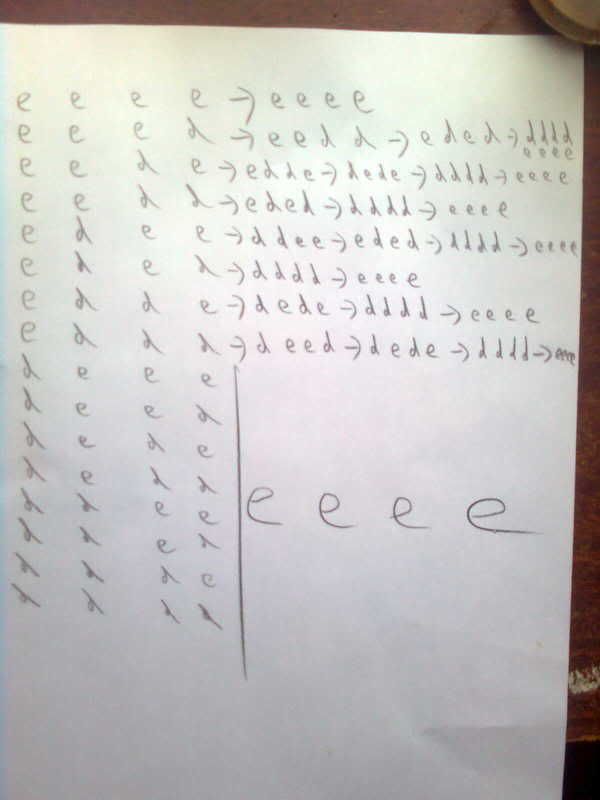
 |
|
#1
|
||||
|
||||
|
i take any binary number and transfrom it into a new number by comparing each digit with the next and the last one with the first, it can be equal , e or disiqual, d
for example the number 0101 in the first transformation becomes dddd and in the second transformation eeee well any binary number eventually transforms to all equal after a number of this transformations check it out:  now what should be the next step?
__________________
 2.4ghz dual core cpu 2.4ghz dual core cpu3gb ram ASUS Radeon EAH4650 DI - 1 GB GDDR2 I PREFER TO LOVE WITHOUT BEING LOVED THAT NOT LOVE AT ALL |
|
#2
|
||||
|
||||
|
Quote:
__________________
 Intel Q9550 @3.3ghz(OC), Asus rampage extreme MOBO, Nvidia GTX470 1.2Gb Vram, 8Gb DDR3 Ram, Win 7 64bit ultimate edition |
|
#3
|
|||
|
|||
|
Coffee?
I like this sort of scale of the Universe, most folk imagine the Universe is everything up from us and out to the cosmos, its not, the Universe is as tiny as it is massive (we cant comprehend how big it is) but its also smaller than we can comprehend too ... Watch until we zoom out from the couple in the park to when we zoom back in again and examine how small things get, this is when it gets interesting IMHO. |
|
#4
|
||||
|
||||
|
wow beautifull video thanks
__________________
 2.4ghz dual core cpu 2.4ghz dual core cpu3gb ram ASUS Radeon EAH4650 DI - 1 GB GDDR2 I PREFER TO LOVE WITHOUT BEING LOVED THAT NOT LOVE AT ALL |
|
#5
|
|||
|
|||
|
Amazing stuff, huh?
Here is another, once the screen loads click the tab in the scale and you can then use your Left/Right arrow keys to navigate between the small and large known Universe ... nice relaxing music too I used to think Atoms were the smallest thing ever ... uh uh ... I wasn't even close. http://primaxstudio.com/stuff/scale_of_universe/ |
|
#6
|
|||
|
|||
|
Matrices probably.
[ eeee , eeed] + [eeed , eeee]---[?,?] etc etc, That should keep you gainfully confused for eighty years or so. Last edited by JimmyBlonde; 09-18-2011 at 12:50 AM. |
|
#7
|
|||
|
|||
|
What you have there, Raaid is (more or less) a one-dimensional cellular automaton. (http://en.wikipedia.org/wiki/Cellular_automaton) Two dimensional ones are usually more interesting (Conways Life being the classic example for computer nerds: http://en.wikipedia.org/wiki/Conway%27s_Game_of_Life). Some years back I did a bit of investigation of these myself, including rendomly-generated rules - with the right parameters, you could sometimes get extremely complex behaviour from apparently-simple systems. I'll see if I can get it running again sometime, and show a few screenshots, if it does (some was written in Borlad Delphi under Win 98, and may not run - I know the later Java stuff does. In fact, I may even have it installed on my netbook. Watch this space...
Edit: Hmmm, I seem to have a problem running the software under Windows on my netbook (grindingly slow) - maybe it'll work better under Ubuntu - or I can run it on the gaming PC. Anyway, for now, Conway's Life running on an 8000 x 8000 grid - order emerges from chaos... 
__________________
MoBo: Asus Sabertooth X58. CPU: Intel i7 950 Quad Core 3.06Ghz overclocked to 3.80Ghz. RAM: 12 GB Corsair DDR3 (1600).
GPU: XFX 6970 2GB. PSU: 1000W Corsair. SSD: 128 GB. HDD:1 TB SATA 2. OS: Win 7 Home Premium 64bit. Case: Antec Three Hundred. Monitor: 24" Samsung. Head tracking: TrackIR 5. Sore neck: See previous. Last edited by AndyJWest; 09-18-2011 at 02:26 AM. |
|
#8
|
|||
|
|||
|
Oooo...my kinda topic. Raaid's example tends to stability, i.e. regardless of the input the final output is eeee. But it does skirt an interesting topic, check out the links AndyJWest supplied above, maybe some 3D fractal videos as well if you'd like to visualise 'chaos'. And if you're a computer boffin then you'll probably like Holland's work on Genetic Algorithms and Cellular Automata.
The question of whether there is 'order in chaos' has kept me busy for many years. 
|
 |
|
|